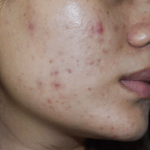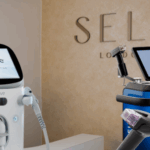
Can laser treatment genuinely change acne, or does it simply calm the surface?
For years, lasers and light devices have been used to help control acne. Most work indirectly: they reduce redness, quiet inflammation, or lower bacterial activity for a time. The AviClear laser is different. It is the first system to specifically target the sebaceous glands, the oil-producing structures known to drive acne formation. By acting on the source of the problem rather than its consequences, this 1726 nm technology represents a new direction in acne management.
Why the sebaceous gland matters
Acne vulgaris is a chronic inflammatory disease centred on the pilosebaceous unit, a hair follicle and its associated sebaceous gland. During puberty, or in response to hormonal shifts, androgens stimulate these glands to produce more sebum. Excess oil mixes with dead cells, blocks pores, and encourages the overgrowth of Cutibacterium acnes. Inflammation follows, resulting in papules, pustules, and sometimes nodules.
Most conventional therapies work by suppressing one or more of these steps: topical retinoids improve cell turnover, antibiotics reduce bacterial load, hormonal treatments lower androgen drive, and isotretinoin shrinks sebaceous glands systemically. All can be effective, but they come with practical or medical limitations. Lasers have long been explored as a non-pharmaceutical alternative, but until recently, they influenced acne only indirectly.
How does older acne lasers work?
Lasers operate through a principle known as selective photothermolysis, which means delivering energy that a specific structure (the chromophore) absorbs while sparing surrounding tissue. Pulsed dye and KTP lasers target haemoglobin in blood vessels, reducing redness and inflammation. Nd:YAG and alexandrite lasers target melanin and haemoglobin, providing deeper dermal heating that can support healing but does not address oil production.
Diode lasers at 1450 nm are sometimes described as sebaceous-targeting, but their energy is actually absorbed by water. Heat diffuses into the gland as a bystander effect rather than being absorbed directly. Light-based systems such as blue and red LED therapy work by reducing bacterial activity. Blue light generates reactive oxygen species within C. acnes, and red light adds an anti-inflammatory effect, but neither changes sebaceous gland activity in a sustained way.
The result is often temporary improvement. These modalities treat inflammation or bacteria effectively, but because the sebaceous gland remains active, breakouts can return once treatment stops.
The science behind 1726 nm technology
Researchers have long sought a wavelength that could safely and selectively target the sebaceous gland. In 2012, Sakamoto and colleagues examined how sebum absorbs light and identified a distinct absorption peak around 1726 nm. In laboratory studies, sebum showed approximately 1.2 times greater optical absorption than water at this wavelength, and laser-induced heating in sebaceous glands was 1.5 times higher than in water. Thermal imaging confirmed focal heating near sebaceous follicles, and histological analysis demonstrated selective gland injury while the surface epidermis remained intact.
These findings suggested that a 1726 nm laser could deliver true selective photothermolysis of sebaceous glands: the energy would be absorbed within the gland’s lipids rather than in surrounding water or pigment. This precision means the glands can be modified without the epidermal injury or post-inflammatory pigmentation risk that sometimes accompany other laser types.
How the AviClear laser works in practice
The AviClear system uses a 1726 nm diode laser coupled with a sapphire cooling plate that maintains the skin surface between 0°C and 5°C. This allows energy to reach the sebaceous glands, typically located 200–750 microns below the surface, while protecting the epidermis. Each treatment lasts around thirty minutes, and most patients complete three sessions spaced a month apart.
Because there is no visible endpoint such as redness or frosting, the laser operates to a target fluence or specific energy level known to correlate with sebaceous gland damage. Patients usually tolerate treatment well without anaesthetic; reported discomfort scores average around five out of ten.
The wavelength’s low absorption by melanin allows safe use across all Fitzpatrick skin types, an important consideration for patients with darker skin who have historically had fewer safe device options.
Evidence from clinical studies
In a prospective study of seventeen patients who underwent three AviClear treatments, inflammatory lesion counts reduced by 52 per cent after one month and by 97 per cent twenty-four months after the final session. A larger open-label study of 104 patients with moderate to severe acne found that at three months, 87 per cent showed measurable improvement and 36 per cent were rated clear or almost clear. At twelve months, 93 per cent had improved, with 68 per cent achieving clear or almost clear status.
These figures are remarkable for a device-based treatment and suggest a sustained physiological change in the glands rather than a temporary cosmetic effect. Improvements tend to continue for several months as oil production decreases and inflammation resolves.
AviClear’s main potential side effects are mild and transient: temporary redness, swelling, or short-lived acne flare. No long-term complications have been reported in published studies.
Comparing AviClear with other 1726 nm systems
Another system, the Accure laser (currently not available in the UK), uses the same wavelength but a different delivery method. It is a fibre-based platform that measures surface temperature in real time to achieve a target epidermal temperature between 40°C and 46°C, using forced-air cooling for comfort. Treatment parameters and spot sizes vary slightly, but both devices rely on the same fundamental principle: selective photothermolysis of sebaceous glands.
The Accure system requires anaesthetic for most patients and slightly longer treatment times. Early studies report reductions of up to 80–90 per cent in inflammatory lesions after four monthly sessions, though much of the data remains unpublished. At present, AviClear has the more established clinical evidence and remains the benchmark for this wavelength in practice.
What this means for patients
For people living with moderate to severe inflammatory acne, the 1726 nm laser represents a genuine advance. It offers a non-pharmaceutical option that targets the biological driver of acne, sebum overproduction, without the systemic risks associated with isotretinoin or long-term antibiotics. It can also be integrated into existing treatment plans: for example, alongside topical therapy or hormonal regulation for women with adult acne.
Patients often describe their skin becoming less oily within weeks, followed by a gradual decline in breakouts. Improvement continues for several months after the final session, and many maintain clearer skin without maintenance medication.
Because the laser does not rely on melanin absorption, it can be used safely on darker skin types and is appropriate for both men and women. At Self London, we consider it particularly helpful for those who have previously relapsed after isotretinoin, those planning pregnancy, or those simply seeking an evidence-based alternative to oral medication.
Frequently asked questions
How many AviClear laser treatments will I need?
Most patients require three sessions at monthly intervals. A minority request a fourth session or annual maintenance if acne is hormonally active.
Is AviClear laser treatments suitable for all skin tones?
Yes. The wavelength is not absorbed by melanin and is therefore safe across all Fitzpatrick skin types.
When will I notice improvement?
Many patients report reduced oiliness within weeks. Visible clearance usually develops over three to six months.
Can AviClear laser treat acne scars?
No. This laser is for active acne. Once inflammation is controlled, residual scarring can be treated separately with fractional or resurfacing lasers.
Is there downtime?
Only mild redness or warmth for a few hours. Most people return to work or study the same day.
The Self London perspective
At Self London, we see the arrival of the 1726 nm laser as part of a broader shift in dermatology, towards treatments that improve how skin functions, not just how it looks. By focusing on the sebaceous gland, this technology aligns with our philosophy of addressing root causes and supporting long-term skin health.
All treatments are consultant-led, with baseline imaging and follow-up assessment to document objective progress. For patients who have lived with acne for years and are ready for a different approach, AviClear offers a route grounded in science and guided by safety.
To explore whether this treatment is right for you, book a consultation at our Harley Street clinic. We will assess your skin, review your history, and create a plan tailored to your needs, whether that includes laser therapy, medical treatment, or both.





